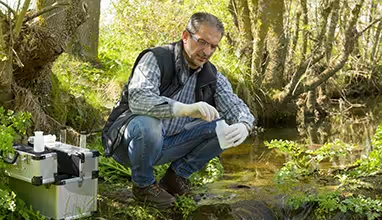The amount of education that a wildlife biologist needs to secure the best job possible varies depending upon the position desired. Many employers ask for a minimum of a bachelor’s degree. Others, however, may require additional training depending upon the work to be completed. Some wildlife biologists advance with a doctorate degree.
High School
A high school diploma or its equivalent is a required part of a wildlife biologist education. Individuals who want to explore this career can begin taking classes during high school in order to prepare for their higher education experience. Science courses, such as biology, chemistry and anatomy are good foundations during which to begin this career. Laboratory work is especially helpful in preparing students for college lab work to come. Some other good courses to enroll in include mathematics, computer courses and language arts electives. Students should strive to obtain a high grade point average and excellent standardized testing results in order to get into the best college program available.
Bachelor’s Degree
Most wildlife biologist positions require some sort of bachelor’s degree. The degree should be in some type of science field related to wildlife studies, such as zoology, biology, ecology or wildlife management. Students will learn about the study and care of animals, dangers that organisms face and procedures for wildlife research. Any lab classes and field internships offered by the college make excellent additions to wildlife biologist training. It will take an average of four years to earn this degree. Students should expect their education to cost around $6,585 per year when attending a state university. Extra fees may apply, especially for housing. Many students also volunteer at zoos or animal centers.
Master’s Degree
Wildlife biologists who wish to advance in their careers can do so with a master’s degree in a wildlife major. Most master’s degrees for wildlife biologists consist of two to three years of education. Many schools offer degrees in wildlife biology, though similar studies are also appropriate. Some of the things that are covered during this education include conservation, federal laws regarding wildlife, terrestrial and aquatic studies and other areas of interest. Students who complete a master’s degree may be eligible to work with federal or state agencies upon graduation. The cost of a master’s degree is around $14,825. Apprenticing with another wildlife biologist with more experience is helpful, too.
Doctorate Degree
Biologists who wish to become wildlife experts in their field may go on to obtain their doctorate degrees. Students will study habitat relationships, endangered species, stream ecology, predator ecology,and many other advanced courses. This training takes four to six years to complete and cost an average of $48,400 per school year. Candidates who choose to do so may also obtain their certification through The American Fisheries Society or The Wildlife Society. Joining these societies can also give wildlife biologists a competitive career edge.
Extensive training is required in order to succeed as a wildlife biologist renders it a profession for those who truly wish to spend a lifetime studying and caring for wildlife. People with a background in wildlife biology have a plethora of career opportunities open to them based on their experience and knowledge. Many other biology and science fields will accept these credentials as well.






